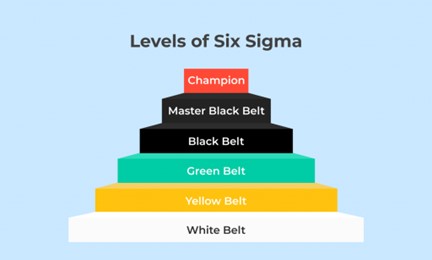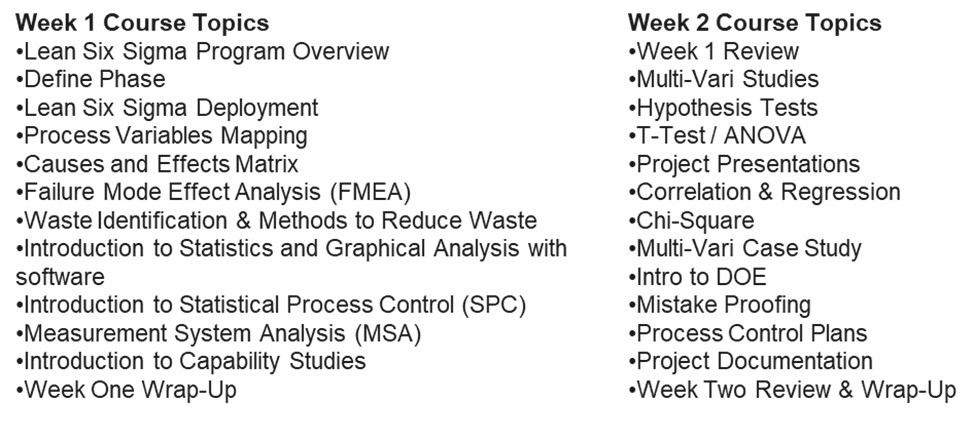
Lean Six Sigma Green Belt is where your more advanced training and certification begins. If you are already a White or Yellow Belt, you have learned some of the basic concepts of Lean Six Sigma. Green Belt is where your learning really takes off.
Role of the Green Belt
The hierarchy of Lean Six Sigma belt levels:
As you can see, the Green Belt (GB) is the third level in the Lean SIx Sigma (LSS) hierarchy. Above GB are the Black Belt (BB), Master Black Belt (MBB) and Champion. Below are the Yellow Belt (YB) and White Belt (WB).
While trained and certified in LSS methodology, GB is a part time activity which is a supplement to your assigned job. Depending on your organization’s needs, GBs can expect to spend between 10-50% of their work time on LSS projects.
GBs typically lead data collection efforts and validate the measurement system on their project teams. They also help improve team function and dynamics by using facilitation skills and leading brainstorming sessions.
Here are some of the tasks which the GB can engage in:
- Operate under the supervision of a Lean Six Sigma Black Belt
- Analyze and solve quality problems
- Coordinate with the data collection process team for their project and validate the measurement system
- Lead and work on projects within their own functional area
- Improve their team facilitation skills.
- Develop Project Charter and SIPOC (Supplier, Input, Process, Output, Customer) Diagram for their project.
How can you get trained and certified?
There are several ways you can achieve your GB. You can start at WB, move up to YB, and then to GB. Or you can get certified first as a YB and then move directly to GB. Finally, you can just start at the GB level of training and certification and possibly move on to Black Belt or Master Black Belt.
To be known as a certified GB you must complete a set of common requirements. Since there is no centralized and recognized accreditation organization, GB training and requirements may vary depending on where you get your training and who you work for.
Currently, GB candidates can get their certification from their own organization, external consultants, professional organizations like the American Society of Quality (ASQ), or even universities or university related subcontractors. Training options include classroom, online (instructor-led or self-paced), or using a hybrid approach of both classroom and online.
As mentioned above, there is no standard set of requirements that are universally accepted. Here are some of the more common approaches to GB training and certification.
- Training
- Length of Training: Minimum 40 hours, with 80 hours preferred
- Classroom Size: Limited to 25-35
- Curriculum: Should include all elements of the Six Sigma Book of Knowledge (BOK) as described by the American Society of Quality (ASQ) or the LSS 6002 Lean Six Sigma Green Belt Training Draft International Standard
- Principal Instructor: Should be a certified MBB or BB
- Testing
- It is recommended that interim assessments of progress be done during training
- At a minimum, candidates must pass a final exam that’s cumulative in nature
- Passing the exam without doing a project will allow you to receive a certificate of training — but not certification
- Project
- It’s recommended a minimum of one project be completed to demonstrate the candidate’s knowledge and ability to apply the LSS methodology and tools, including statistical analysis. The project should have a moderate financial or operational impact on your organization
- Software
- GB candidates need to learn how to use an appropriate statistical software package as part of their training program. Basic statistical analysis and graphical tools should be the focus rather than complex and advanced statistics
Here is an example of one organization’s topical outline for an 8-day (64 hours over two months) classroom GB training:

The same organization offers a similar outline for their Green Belt Live Virtual Instructor-Led training which is 8-days (48 hours) over 2 months, delivered by a Master Black Belt instructor via Zoom. A self-paced version is also available.
In this example, if you wish to be certified, there is a separate process and additional cost in which they can coach you through a project and then approve it for final certification. This specific format and the topics are not being endorsed but are only shown as an example of your options for being GB trained and certified.
FAQs: Lean Six Sigma Green Belt training and certification
How long does it take to get Green Belt certified?
The time it takes you to get fully certified as a Green Belt will be highly dependent on who you select. A complete training should take between 40 and 80 hours over the course of one to two weeks with 80 hours and two weeks being the preferred length of time for the adequate learning of the content. This format usually has one month between the two training weeks so you can start working on your project. It will be less if your training already incorporates a simulation or case study instead of a real business project.
A comprehensive project may take up to 3 to 4 months to complete and start implementation. The value of your project may range from $50,000 up to millions of dollars depending on the project you select.
Does Green Belt certification require the completion of a project?
Yes, but due to the lack of an industry standard, some organizations will use a case study or simulation during training to serve as a substitute for a real work project. If you are being trained and certified by your organization, you can expect to do a project which would have tangible benefits back to the organization. Furthermore, some training organizations will offer a project option for which you pay extra or in some cases, will require you to get your certification from a third-party who does nothing but offer certifications.
Should I get White or Yellow Belt trained and certified before getting my Green Belt?
That is an individual choice for you to make. If you are unsure whether Lean Six Sigma (LSS) is for you, starting with one of the lower belts will give you a chance to assess your interest and capabilities. If your organization selects you for internal Lean Six Sigma training, it would be wise to accept the invitation to demonstrate your support of the organization’s LSS journey and willingness to learn something that shows your value to the organization.
To summarize
Green Belt (GB) training and certification is the sweet spot of Lean Six Sigma (LSS) training and certification. Organizations implementing LSS rely heavily on GBs to provide value to the organization in the form of impactful projects as well as supporting the creation of a continuous improvement culture.
While not a full-time job or considered the professional level of LSS certification, it often allows you to stand out amongst your peers as someone with added value to the organization. If you are looking to be trained and certified outside of your organization, beware of taking short cuts or basing your decision on price. A GB certification obtained from someone with few credentials and reputation will not be of any benefit to you or your employer, current or future.